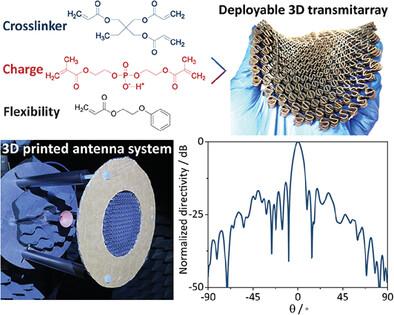当前位置:
X-MOL 学术
›
Adv. Funct. Mater.
›
论文详情
Our official English website, www.x-mol.net, welcomes your
feedback! (Note: you will need to create a separate account there.)
Charge-Programmable Photopolymers for 3D Electronics via Additive Manufacturing
Advanced Functional Materials ( IF 18.5 ) Pub Date : 2024-01-25 , DOI: 10.1002/adfm.202313839
Zhen Wang 1, 2 , Junbo Wang 3 , Zhenpeng Xu 1, 2 , Ryan Hensleigh 2 , Haotian Lu 1, 2 , Mack Sowers 1 , Marcus A. Worsley 4 , Yahya Rahmat‐Samii 3 , Xiaoyu (Rayne) Zheng 1, 2, 5
Advanced Functional Materials ( IF 18.5 ) Pub Date : 2024-01-25 , DOI: 10.1002/adfm.202313839
Zhen Wang 1, 2 , Junbo Wang 3 , Zhenpeng Xu 1, 2 , Ryan Hensleigh 2 , Haotian Lu 1, 2 , Mack Sowers 1 , Marcus A. Worsley 4 , Yahya Rahmat‐Samii 3 , Xiaoyu (Rayne) Zheng 1, 2, 5
Affiliation

|
Charge-programmed 3D printing enables the fabrication of 3D electronics with lightweight and high precision via selective patterning of metals. This selective metal deposition is catalyzed by Pd nanoparticles that are specifically immobilized onto the charged surface and promises to fabricate a myriad of complex electronic devices with self-sensing, actuation, and structural elements assembled in a designed 3D layout. However, the achievable property space and the material-performance correlation of the charge-programmed printing remain unexplored. Herein, a series of photo-curable resins are designed for unveiling how the charge and crosslink densities synergistically impact the nanocatalyst-guided selective deposition in catalytic efficiency and properties of the 3D printed charge-programmed architectures, leading to high-quality 3D patterning of solid and liquid metals. The findings offer a wide tunability of the structural properties of the printed electronics, ranging from stiff to extreme flexibility. Capitalizing on these results, the printing and successful application of an ultralight-weight and deployable 3D multi-layer antenna system operating at an ultrahigh-frequency of 19 GHz are demonstrated.
中文翻译:

通过增材制造用于 3D 电子的电荷可编程光聚合物
电荷编程 3D 打印能够通过金属的选择性图案化制造轻质且高精度的 3D 电子产品。这种选择性金属沉积是由专门固定在带电表面上的 Pd 纳米颗粒催化的,有望制造出无数具有自感知、驱动和按照设计的 3D 布局组装的结构元件的复杂电子设备。然而,电荷编程打印可实现的性能空间和材料性能相关性仍有待探索。本文设计了一系列光固化树脂,用于揭示电荷和交联密度如何协同影响纳米催化剂引导的选择性沉积,从而提高 3D 打印电荷编程结构的催化效率和性能,从而实现高质量的固体 3D 图案化。和液态金属。这些发现为印刷电子产品的结构特性提供了广泛的可调性,从刚性到极端的灵活性。利用这些成果,展示了在 19 GHz 超高频下运行的超轻量级可部署 3D 多层天线系统的打印和成功应用。
更新日期:2024-01-25
中文翻译:

通过增材制造用于 3D 电子的电荷可编程光聚合物
电荷编程 3D 打印能够通过金属的选择性图案化制造轻质且高精度的 3D 电子产品。这种选择性金属沉积是由专门固定在带电表面上的 Pd 纳米颗粒催化的,有望制造出无数具有自感知、驱动和按照设计的 3D 布局组装的结构元件的复杂电子设备。然而,电荷编程打印可实现的性能空间和材料性能相关性仍有待探索。本文设计了一系列光固化树脂,用于揭示电荷和交联密度如何协同影响纳米催化剂引导的选择性沉积,从而提高 3D 打印电荷编程结构的催化效率和性能,从而实现高质量的固体 3D 图案化。和液态金属。这些发现为印刷电子产品的结构特性提供了广泛的可调性,从刚性到极端的灵活性。利用这些成果,展示了在 19 GHz 超高频下运行的超轻量级可部署 3D 多层天线系统的打印和成功应用。

































 京公网安备 11010802027423号
京公网安备 11010802027423号